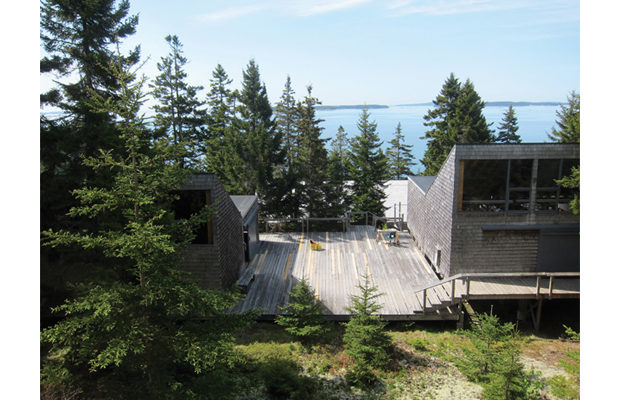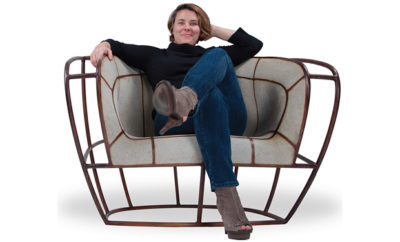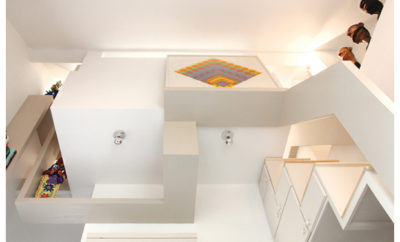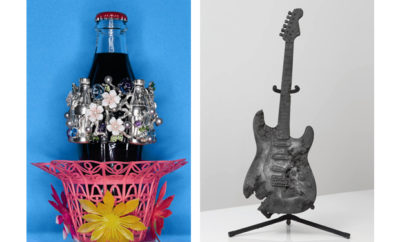 Haystack’s award-winning campus on Deer Isle, Maine, was designed by Edward Larrabee Barnes in 1960. This view from the dining hall shows the fiber studio on the left, jewelry studio on the right, and Jericho Bay in the distance.
Haystack’s award-winning campus on Deer Isle, Maine, was designed by Edward Larrabee Barnes in 1960. This view from the dining hall shows the fiber studio on the left, jewelry studio on the right, and Jericho Bay in the distance.
Feature
Haystack Diary
Last summer I had lunch with my friend Rama Chorpash, a talented designer and director of the industrial design department at Parsons, the New School for Design. He told me about a residency he’d had at Haystack Mountain School of Crafts. Only in its second year, the Haystack Open Studio Residency is an honor bestowed on fifty or so creative people each spring. Residents are given studios, meals, and housing and have the run of the place to focus on their craft and exchange ideas. Rama said it was an amazing experience so I put it in my calendar to apply for the 2014 program.
Haystack is located on beautiful Deer Isle, Maine. It was founded in 1950 (near Haystack Mountain with a later move to the coast) as a place to nurture fine craftsmanship. Its mission has been updated in recent years to include the exploration of craft in all aspects of the arts. I, for example, am not a fine craftsman, but my design ideas often touch on or incorporate craft. The residency is open to artists, designers, and craftspeople, and the diversity of the group is its strength.
As it turns out, the residency started three days after my fiftieth birthday. I had been envisioning a yoga retreat or travel, but this was the perfect gift— a challenge to create with my hands, though I was not sure how I would function in this environment. It was like going back to school. And two weeks in an unheated cabin in the woods with an unknown roommate was a concern.

The bell tower by sculptor George Greenamyer. When it rang, we ate.
May 25th
Awake at 6 a.m. and on the road by 6:40.
Early on I decided I would not bring work from the studio, but at the last moment I decided to bring some fledgling projects just in case. Along with my clothes and bedding, I load an Eames fiberglass chair shell (just the shell, no legs), four empty wine bottles, and a box of colored glue into the car.
Wait until Deer Isle to eat lunch, a lobster roll at the local ice cream parlor. Arrive at Haystack at about 2:40 p.m. The residents are slowly arriving and I meet a few people. I claim a desk in the fiber studio as it looks clean and has a nice view of the water. Also, several of my projects might incorporate soft elements.
Dinner is served family style. It’s healthy and plentiful and I meet a few more residents at my table. We are welcomed at dinner by Stuart Kestenbaum, the charming poet who runs the school. He is quick-witted and knowledgeable. Stuart, it turns out, makes an appearance at most meals.
Later in the evening I finally meet my roommate, a mellow artist from Brooklyn. Whew. The cabin is very cold, but I am settled.
May 26th
Awake 6 a.m. Do some yoga in the auditorium. A few others are practicing yoga also and meet up most days during the residency at 6:30 a.m. It’s early but breakfast is at 8. Fog gives way to a cool sunny day.
Settle in the fiber studio and sketch. Insecure about what I will do with my time here, I share some of my ideas with the fiber studio tech, Carrie Dickason. She suggests some research in the library, which is one of the few heated rooms in the school. I linger in the warmth as I research textile artist Gyöngy Laky and the sculptor John McQueen. I am in a new world of craft, and I love all of the new information. There is much to learn. I decide my direction— a combination of working with the things I brought and incorporating local materials. Some projects are forming in my head.
Things are off to a slow start. Residents are setting up. Most have brought their own supplies. The school provides equipment but materials are the resident’s responsibility. I must go shopping tomorrow.
After lunch Stuart leads a tour of the property. The school is located on a beautiful rocky hill leading down to the sea. Mounds of soft moss and lichen feed off fog. The forest is predominantly spruce and fir. On the walk I catch glimpses of water and sunlight through the bare weathered branches. I might try to incorporate some of these sticks into a project.
Haystack is housed in buildings designed by famed modernist architect Edward Larrabee Barnes. The cabins and studios are humbly constructed, and shingled on the outside, but their lofty angled ceilings give them a defining form and their large windows take advantage of the beautiful site. It reminds me of the Pines in Fire Island. The bathrooms are small and cramped but as far as I am concerned Haystack has its priorities right.
I’m very happy with my selection of studios. Turns out most of the residents in fiber are women or gay, or both. At one point I jokingly ask if I have accidentally joined a coven, and apparently I have! The nickname sticks. I form an immediate bond with the people around me. Textile artists Judith Leeman and Liz Collins and collage artist/quilter Aaron McIntosh form the core of my support system, of my new creative circle, “The Coven.” It’s a joke, of course, but the energy in the studio is very real.
In the evening the first half of the residents present their work. The format is ten slides, twenty seconds each. It’s a lot of information, but we are visual people and it is great to pair images of work with the residents. It is an impressive group of creative individuals.

My new friends in the fiber studio (left to right), Yunjung Kang, Liz Collins, Judith Leemann, and Aaron McIntosh.
May 27th
Awake 6:24. Yoga in the auditorium.
I head into town. The drive is beautiful. Shopping is part of my process and the hardware store is impressively stocked with everything on my list plus a few things I find along the way. I search in vain for another lobster roll, but restaurants are still closed for the season. I buy some wine and socks and just make it back in time for lunch.
I attempt my first project. I thought I might be able to work with silicone and broken bottles. But after breaking the bottles I realize it is not going to work. It’s too difficult to get the shards organized. I make a mess, but the glue works, so that is progress, and I realize it would be much better if the bottles were cut into cylinders—easier to reorganize and a more deliberate statement.
I remove the rim on my Eames shell in the metal shop with a hand-held grinder. After, I find a desk in the wood studio to begin work on my chair project. I plan to use the shell as a form over which I will build a chair. I create a wooden base, mount the shell, and my jig is complete.
After dinner the second half of the residents, including myself, present their work in rapid-fire succession. My work sticks out as being very commercial.
May 28th
Another very cold night, bad sleep. No yoga. Breakfast tastes good.
Gathered sticks in the moist woods. My new fiber friends are encouraging me to explore lashing and weaving as forms of attachment, and I like the idea, but I have brought these amazing colored glues with me and I do not want to get too crafty.
I start to attach dowels to the chair model. Inspired by the work of Gyöngy Laky I develop a system of screwing the dowels together—no lashing, no glue, just small countersunk screws. It goes together easily. The best projects do. I use masking tape to hold the dowels in place before screwing them. Someone jokes about my “masking tape joinery,” but I know I am onto something.
After dinner I sketch in the fiber studio and later walk down for a drink at the bonfire that has been lit on the rocks by the ocean.
May 29th
6:30 yoga. Breakfast.
The “Fab Lab” is a studio dedicated to digital fabrication, and although I will not use it to its greatest potential I am excited to have access to make some accurate templates and molds. The studio techs help me cut a hemisphere as a form for my stick bowl.
I run to the hardware store for more dowels and spend the afternoon in the wood shop screwing dowels together over my form. The chair comes off for the first time, and my idea is working!
After dinner, I walk down to the ocean with Liz—it’s gorgeous, clear, and cool. Then back to the fiber studio to try out the sticks. I make my first pass and it looks to be working, but unfortunately I totally underestimated the quantity of sticks I need.

My chair takes form as dowels are held in place with masking tape and then screwed together over an Eames shell.
May 30th
Sleep till 8. Gather sticks all morning. Times flies. I spend some time on the internet in the library. This is the only place one can get wireless and it is often not working. Haystack only has a wireless connection and does not encourage the use of cell phones on campus. It’s nice being disconnected, but a few projects at home need attention.
The Haystack environment is a perfect place for new ideas. After my failure with the broken bottles I realized this concept would be much more successful if it were more organized. The breaking was too random and hard to reconcile, but cylinders of glass could easily be glued, and I am wondering if it might be possible to combine the glass cylinders with some ceramics. I ask Farrell Ruppert, the studio technician in the metal shop, if there might be a way to cut my bottles into cylinders.
The best aspect of this residency is the cross-pollination between studios. As soon as I decide I want to make some ceramics I talk to the studio tech, Siem van der Ven, claim a cubby in the pottery studio, make a template in Fab Lab, and am ready to work on my ceramics ideas tomorrow.
Witchy evening in the fiber studio! I work on my stick bowl, sketch, laugh, and dance with my very fun, hardworking studio mates. Off to bed at 1:40 and they are still working.
May 31th
Yoga at 6:30. Breakfast at 8.
Ceramics all day. I have not made pottery since high school, and it is fantastic getting back into it. With some help from the folks in the ceramics studio I get up and running with a little slab factory. I extrude clay cylinders and make donuts and disc components that will be joined with silicone.
There has been much talk of the Deer Isle dump. Often it is a place for Haystack residents to find materials, and Liz and I feel compelled to check it out this morning, but it is disappointing and sort of depressing. We also run into town and pick up some wine for tonight—a special Saturday night lobster party on the rocky bluff below the school.
Work on stick bowl in the evening. Need more sticks.

Clothespins salvaged from the fiber studio are glued over a blue foam mold.The completed Clothespin bowl.
June 1st
Sleep in till 9! Miss breakfast! Shower, wash socks. Putz around in various studios all morning. I am in three studios now and everyone is making fun of me running around, but I am good at multitasking and most projects, after they are set up, require only a little bit of attention every day.
My ceramics make it into the bisque kiln.
Gather more sticks, and my stick bowl is taking shape, but I try to lift it off the mold this morning and discover that the vinyl glue is a little soft and it is not holding its shape.
The Coven, plus or minus a few, duck out for dinner at the Fisherman’s Friend in Stonington.
June 2nd
What day is it? The weather has been beautiful the last few days, food is plentiful, studios are open 24 hours a day, and the makers that surround me are industrious. Haystack is a utopia where everyone is well fed and employed doing something they love. This morning however it sets in that this Shangri-la of making will soon come to an end. Thursday is clean-up day, Friday we leave, so that leaves three full days of making.
I discover a treasure trove of old clothespins in the fiber studio. They have been used for dying cloth and each one is a different color. I am excited to use them and envision another bowl. I head to the Fab Lab to make another form.
In the afternoon I give some final attention to my chair. It is basically done, supports my weight, and looks great.
In the evening a few of us from the Coven help Liz hang her spider webs down by the water so she can photograph them the next day.
June 3rd
After breakfast I start assembling the clothespin bowl and add another layer to my stick bowl.
Glazing my pottery takes up the whole afternoon. Low fire clay limits my selection of glazes to one—a water blue. It is from 2010 and needs to be strained. The pottery studio is getting organized for a salt firing which is very exciting, but my project will not be part of it. I prepare a smaller kiln for my slab pottery system. My high-school ceramics training comes back to me. I apply a wax resist and create circles of what will be a greenish-blue glaze.
June 4th
After breakfast I spend the morning in the glass cold-working shop. Everyone was very accommodating when I said I wanted to cut glass bottles into strips. The glass shop was not open as part of the residency, but they set up the wet saw just for me. I had collected some new bottles over the last few days and they cut easily.
More stick gluing. More stick gathering. More clothespin gluing.
I am done with my chair so I pack up my desk in the wood shop and bring it back to the fiber studio.
I start assembling the ceramics and glass but decide maybe they are better as separate projects. The ceramics look very handmade next to the glass cylinders.
We all work late into the night and I complete the stick bowl. I have two heaters on it trying to get the glue to dry in time to show it.
June 5th
Breakfast.
Our first truly rainy day is also the last day of making. We are to finish up our projects, clean up the studio, and display our work for an evening “Walk-through.” All of the residents, and a few invited guests from outside, will walk through the various studios to see what the residency has produced. After the Walk-through there will be an auction—which the collector side of me is very excited about—and after all is done we will close the residency down with a dance party.
A residency is time to use as one wishes, and projects do not need to be finished, but the Walk-through is a nice punctuation point to have at the end. I get enough of the clothespin bowl done to make an impression and finish gluing my glass and ceramics. I love the colored silicones and they work very nicely on the glass and ceramics. The thick red and blue beads do exactly as I expect them to. I am however learning as I go. I want to experiment more with silicone when I get home. I bring all of my work to the fiber studio for the Walk-through, and surprisingly it pulls together around my experiments with glue and building structure over forms.

This is one of several sketches exploring concepts that I might eventually build using my Eames chair form. Here, the concept marries my stick bowl configuration with the chair form.
June 6th
After breakfast I say my goodbyes and finish packing up the car. The eight hour drive home passes quickly. Steuart Padwick, a furniture designer from England, travels with me. We are tired from the last night of revelry, stop in Kennebunkport for what has to be the worst lobster roll I have ever had, and talk endlessly about the incredible time we just had.
My reentry into the real world over the next few days is bumpy. Fortunately I have the weekend to decompress, but one realizes, after such an idyllic time and place to work, how little of one’s life is truly creative—life at home is filled with social obligation, business to be chased, and meals to be figured out. It’s hard to carve out creative space for oneself and I feel very privileged to have had my time at Haystack.
Final Notes
I wonder how my residency at Haystack will resonate going forward. I enjoyed exploring new territory but most of what I made were seeds of ideas, not finished products. I will definitely expand upon the idea of building structures over forms, and my gluing experiments produced some nice effects that I would like to take further.
More than anything I appreciate the re-exposure to craft. When I was heavily into pottery in high school I attended a few craft fairs and was wowed by virtuoso craft, but I grew out of it. My design education taught me to start with an idea and figure out how it will get made after. Of course the better the craftsmanship, the better the product, but craft for craft’s sake never made much sense—for me it is a means to an end. That said, I regret the way craft and design were divorced here in the U.S.A. It makes no sense—designers and craftspeople have too much to learn from each other. Liz Collins and I have collaborated on some furniture as part of her show at Art Market Provincetown at the end of August, and in addition to producing some beautiful objects, it has created a valuable dialogue for both of us.
I have long thought that twenty-first-century design will be about undoing much of what we built up in the twentieth century—hopefully reversing some environmental damage and rethinking the systems put in place by industrialization. The “makers movement” is an indication that this process is underway, and there are many style currents in which craft is playing a role. But “making” is more than a style, it is an integral part of the fabric of our society—honest and human and satisfying—and I want to make sure that my work stays grounded in humanity even as it moves into the digital age.












